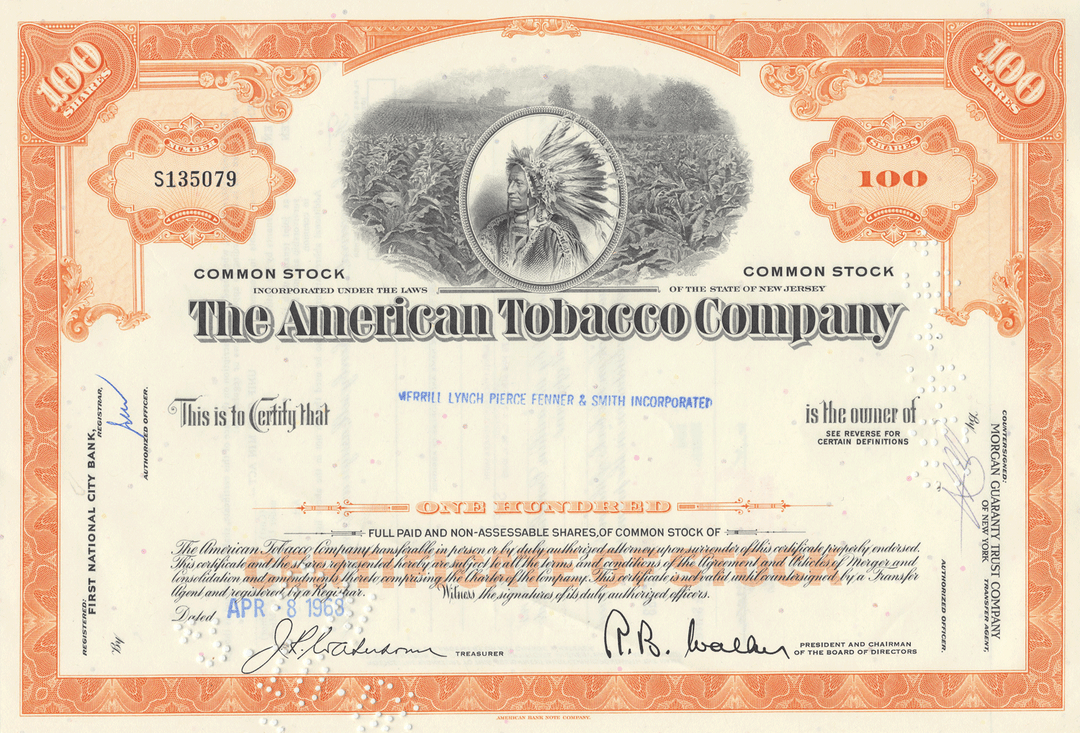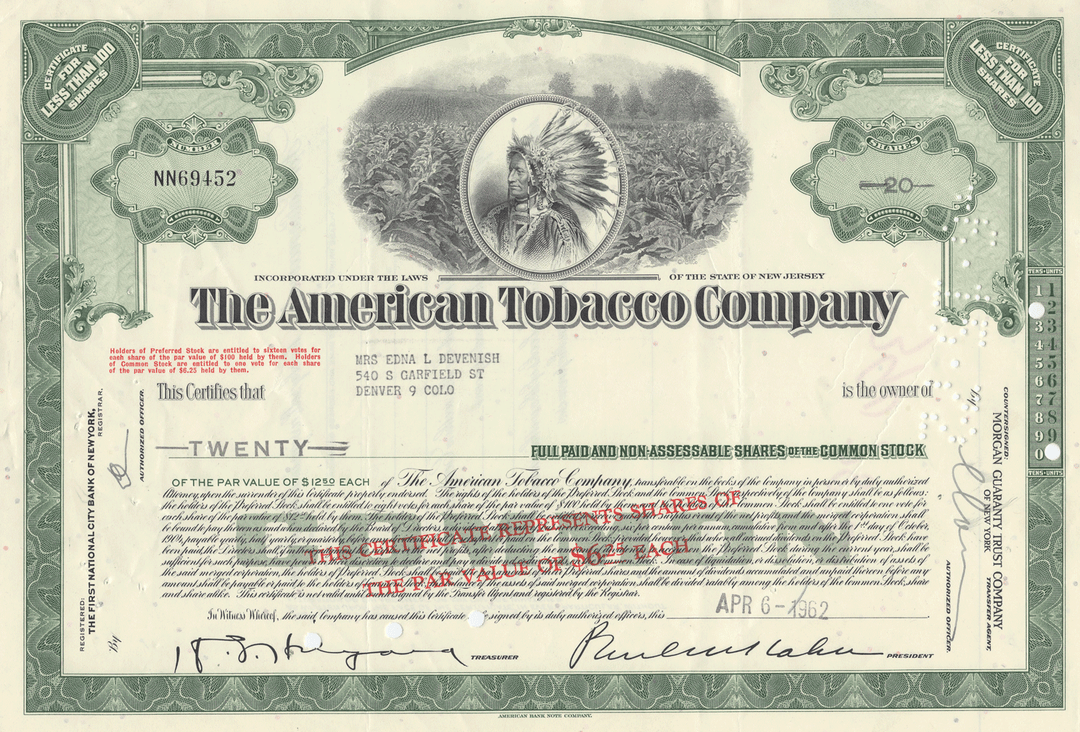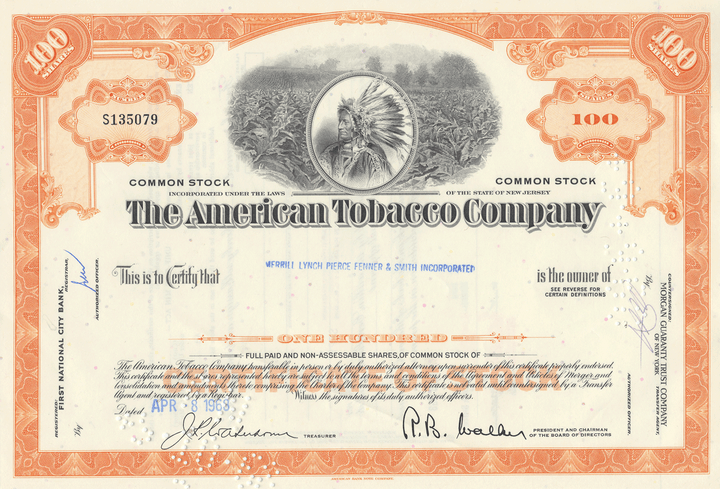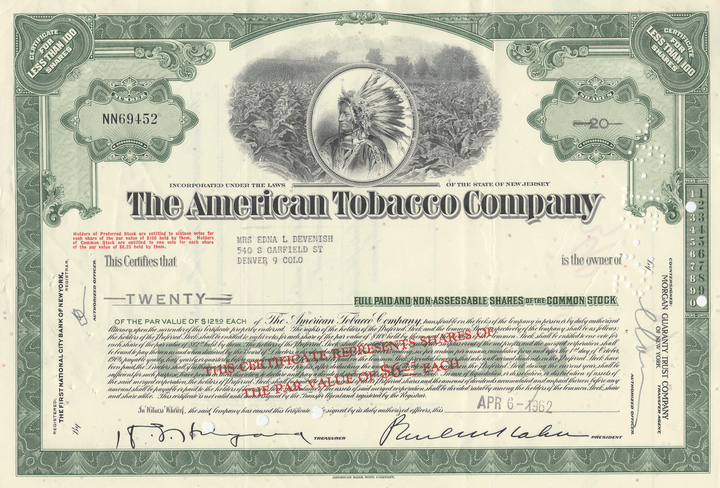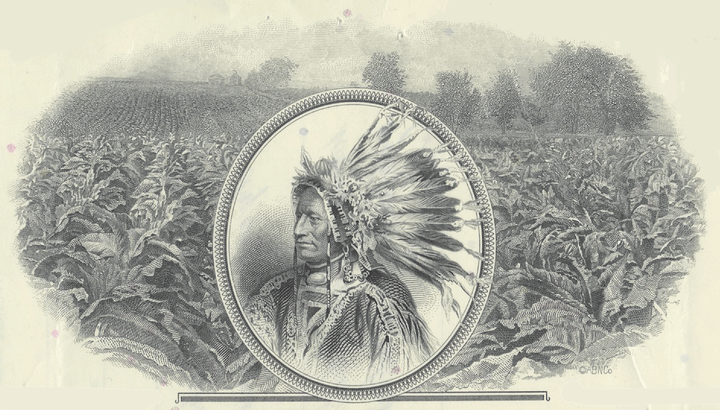American Tobacco Company
- Guaranteed authentic document
- Orders over $75 ship FREE to U. S. addresses
Product Details
CompanyAmerican Tobacco Company
Certificate Type
Common Stock
Date Issued
1960's
Canceled
Yes
Printer
American Bank Note Company
Signatures
Machine printed
Approximate Size
12" (w) x 8" (h)
Images
Representative of the piece you will receive
Guaranteed Authentic
Yes
Additional Details
NA
Historical Context
James Buchanan Duke’s entrance into the cigarette industry came about in 1879 when he elected to enter a new business rather than face competition in the shredded pouched smoking tobacco business against the Bull Durham brand, also from Durham, North Carolina.
In 1881, two years after W. Duke Sons & Company entered into the cigarette business, James Bonsack invented a cigarette-rolling machine. It produced over 200 cigarettes per minute, the equivalent of what a skilled hand roller could produce in one hour, and reduced the cost of rolling cigarettes by 50%. It cut each cigarette with precision, creating uniformity in the cigarettes it rolled. Public stigma was attached to this machine-rolled uniformity, and Allen & Ginter rejected the machine almost immediately.
Duke set a deal with the Bonsack Machine Company in 1884. Duke agreed to produce all cigarettes with his two rented Bonsack machines and in return, Bonsack reduced Duke’s royalties from $0.30 per thousand to $0.20 per thousand. Duke also hired one of Bonsack’s mechanics, resulting in fewer breakdowns of his machines than his competitors’. This secret contract resulted in a competitive advantage over Duke’s competitors; he was able to lower his prices further than others could.
In the 1880s, while Duke was beginning to machine-roll all his cigarettes, he saw that growth rates in the cigarette industry were declining. His solution was to combine companies and found “one of the first great holding companies in American history.” Duke spent $800,000 on advertising in 1889 and lowered his prices, accepting net profits of less than $400,000, forcing his major competitors to lower their prices and, in 1890, join his consortium by the name of the American Tobacco Company. The five constituent companies of American Tobacco: W. Duke & Sons, Allen & Ginter, W.S. Kimball & Company, Kinney Tobacco, and Goodwin & Company – produced 90% of the cigarettes made in 1890, the first year the American Tobacco Company was listed on the NYSE. Within two decades of its founding, the American Tobacco company absorbed about 250 companies and produced 80% of the cigarettes, plug tobacco, smoking tobacco, and snuff produced in the United States. With Duke’s innovation, American Tobacco grew its equity from $25,000,000 to $316,000,000.
The "Tobacco Trust"
American Tobacco Company quickly became known as the “Tobacco Trust” upon its founding. Duke controlled the cigarette market, and his trust caught the attention of legislators in the United States, a country with historical aversion to monopolies.
American Tobacco Company focused solely on making and selling cigarettes, leaving growing of tobacco and retail distribution to independent entrepreneurs. Nonetheless, Duke aimed to eliminate inefficiencies and middlemen through vertical consolidation. The American Tobacco Company began to expand to Great Britain, China, and Japan. The company also maintained an interest in producing other tobacco products in case fads shifted; Duke wanted to be sure that he would be prepared with a multitude of tobacco styles. The Tobacco Trust’s international expansion in conjunction with its consolidation of all types of tobacco “ultimately made the Trust so vulnerable to regulation and judicial dissolution”.
The Sherman Antitrust Act was passed in 1890, and in 1907, the American Tobacco Company was indicted in violation of it. In 1908, when the Department of Justice filed suit against the company, 65 companies and 29 individuals were named in the suit. The Supreme Court ordered the company to dissolve in 1911 on the same day that it ordered the Standard Oil Trust to dissolve. The ruling in United States v. American Tobacco Co. stated that the combination of the tobacco companies “in and of itself, as well as each and all of the elements composing it whether corporate or individual, whether considered collectively or separately [was] in restraint of trade and an attempt to monopolize, and a monopolization within the first and second sections of the Anti-Trust Act.”
Dissolution
Dissolution proved complicated. The American Tobacco Company had combined many prior companies and processes. One department would manage a certain process for the entire organization, producing brands previously owned by other companies. “Plants had been assigned specific products without regard for previous ownership.” Over the course of eight months, a plan for the dissolution, meant to assure competition among the new companies, was negotiated.
The trust needed to dissolve in such a way that no manufacturer had a monopoly on any type of tobacco product. Investors, holding millions of dollars of securities, also needed to be considered. A large question was how to distribute trademarks and brands between the resulting companies.
The American Tobacco Company’s assets were split off into: American Tobacco Company, the existing R. J. Reynolds, Liggett & Myers and Lorillard. The monopoly became an oligopoly. The main result of the dissolution of American Tobacco Trust and the creation of these companies was an increase in advertising and promotion in the industry as a form of competition.
Liggett & Myers
Liggett & Myers kept control of these plants: Liggett and Myers, St. Louis; Spaulding and Merrick, Chicago; Allen and Ginter, Richmond; smoking tobacco factory in Chicago; Nall and Williams, Louisville; John Bollman Company, San Francisco; Pinkerton Company, Toledo; W. R. Irby, New Orleans; two cigar factories in Baltimore and Philadelphia, and the Duke-Durham branch of the American Tobacco Company.
P. Lorillard
P. Lorillard retained the Lorillard properties in addition to S. Anargyos; the Luhrman and Wilburn Tobacco Company; plants in Philadelphia, Wilmington, Brooklyn, Baltimore, and Danville; and the Federal Cigar Company.
Related Collections
Additional Information
Certificates carry no value on any of today's financial indexes and no transfer of ownership is implied. All items offered are collectible in nature only. So, you can frame them, but you can't cash them in!
All of our pieces are original - we do not sell reproductions. If you ever find out that one of our pieces is not authentic, you may return it for a full refund of the purchase price and any associated shipping charges.






